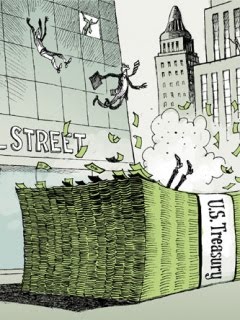Ticker: C
Sector: Banks
Listing: NYSE
Introduction
Citigroup is a universal bank which is operating in more than 140 countries across five continents. The bank is split into two major groups; Citicorp and Citi Holdings. The former comprises the following businesses that form the core to their strategy of being the global bank that provides excellent services; investment banking, private equity, research and analysis, sales and trading, institutional asset management, retail and business banking. The latter comprises the following that the bank will dispose when market conditions improve; brokerage, asset management and loans, which represent higher risk of default. Special Asset Pool, also part of the latter group, consists of assets and loans that are likely to be written off due to their very high risk nature.
Analysis
The bank is currently restructuring itself due to the 2007 credit crisis which eventually turned into a global banking crisis of 2008 that resulted in the worse global recession since the Great Depression. Initially, it was too diversified trying to be the jack of all trades and master of almost none. It was basically comprised of basically separate companies in all but name. The bank got into huge trouble during the crisis and asked the US government for bailout in the form of equity stake and TARP (Troubled Asset Relief Program). The bank made a loss in 2009 due to the assets that have been written off in Citi Holdings. Securities and Banking and Transactional Services divisions have managed to increase profits quite significantly compared to 2008. This is because of the following; firstly, consolidations took within industries in general since some competitors got into trouble during the crisis. Secondly, many companies needed to raise capital via the markets. Thirdly, firms and governments needed to borrow funds from investors to shore up their finances. Profits from the Regional Consumer Banking fell compared to the same period. This is because consumers did not borrow as much before the crisis so they chose to save, some businesses went under and others could not get the required loans.
This goals for the 2010 financial year are:
- Preserve high levels of capital, liquidity and reserves
- Mitigating credit costs
- Improve profitability and efficiency of operating businesses of Citicorp operating from their strong performances in 2009
- Reduce assets in Citi Holdings even further.
- Invest strategically in innovation and the Citicorp businesses that aid Citi’s future earnings potential
- Improve on their already leading global position, especially in emerging markets.
- Maintaining and expanding their role as a constructive organisation globally, influencing public policy debates and meeting economic and social goals. [I believe that this is important because they need to regain public trust in banks since the media in general and many politicians gave them a bad name and turned the majority of people against them.]
The Executive Management's statement, from the latest annual report, is quite optimistic. However, the bank does state that there are some uncertainties in terms of new legislation and macroeconomic outlook.
In the first quarter, the bank had a much better time. Overall, they made a good profit, which the Securities and Banking division have done extremely well. Losses from defaults have gone down and the balance sheet has been strengthened further. The bank has exited from TARP and the US state is going to sell it's stakes in an economically rational manner, because the government knows the bank can stand survive on it's own. The management is very optimistic in the long term. However, there is a tone of uncertainty in the short term due to the uncertain macroeconomic factors.
Financial ratios as at the close of 6/5/2010:
The financial ratios of other companies in the same sector can be viewed here. (1)
Using the contrarian strategy, the stock does only satisfies some of the criteria. However, I am prepared to use P/BV as the core ratio in this case. This is because:
The financial ratios of other companies in the same sector can be viewed here. (1)
Using the contrarian strategy, the stock does only satisfies some of the criteria. However, I am prepared to use P/BV as the core ratio in this case. This is because:
- Only P/BV is below sector average, making it cheaper compared to it's peers. The stock does not qualify in terms of other contrarian ratios. As mentioned earlier, the bank made a small loss due to the worst crisis in recent history. Also P/CF is negative.
- Dividend yield is way below sector average.
- With a whopping dividend cover of -76, the bank cannot afford to greatly increase and sustain it in the short term.
- Current ratio does not apply to banks in general so that is why I did not include it. More importantly, the total assets has to be greater than total liabilities which is true in this case.
- The P/S ratio is below sector average, making it cheap compared to it's peers.
- The bank's earnings are below that of S&P 500, which is $50.97 (2) for the latter. Earnings are not likely to plummet in the near future since the bank has made a profit in the first quarter.
Conclusion
Based on all of the information I have researched, I believe that the stock is a good buy in the long term, based on the P/BV and P/S ratios and it will earn a good profit this financial year. This is because the bank will make a spectacular come back and dividends will be possibly paid in near future.
Note
I will not be responsible for any losses incurred by investors through investing in this stock. Investing in the stock market may result in not getting their initial amount back.
Source:
- ADVFN retrieved on 6/5/2010.
- Standard & Poors retrieved on 14/5/2010.







No comments:
Post a Comment